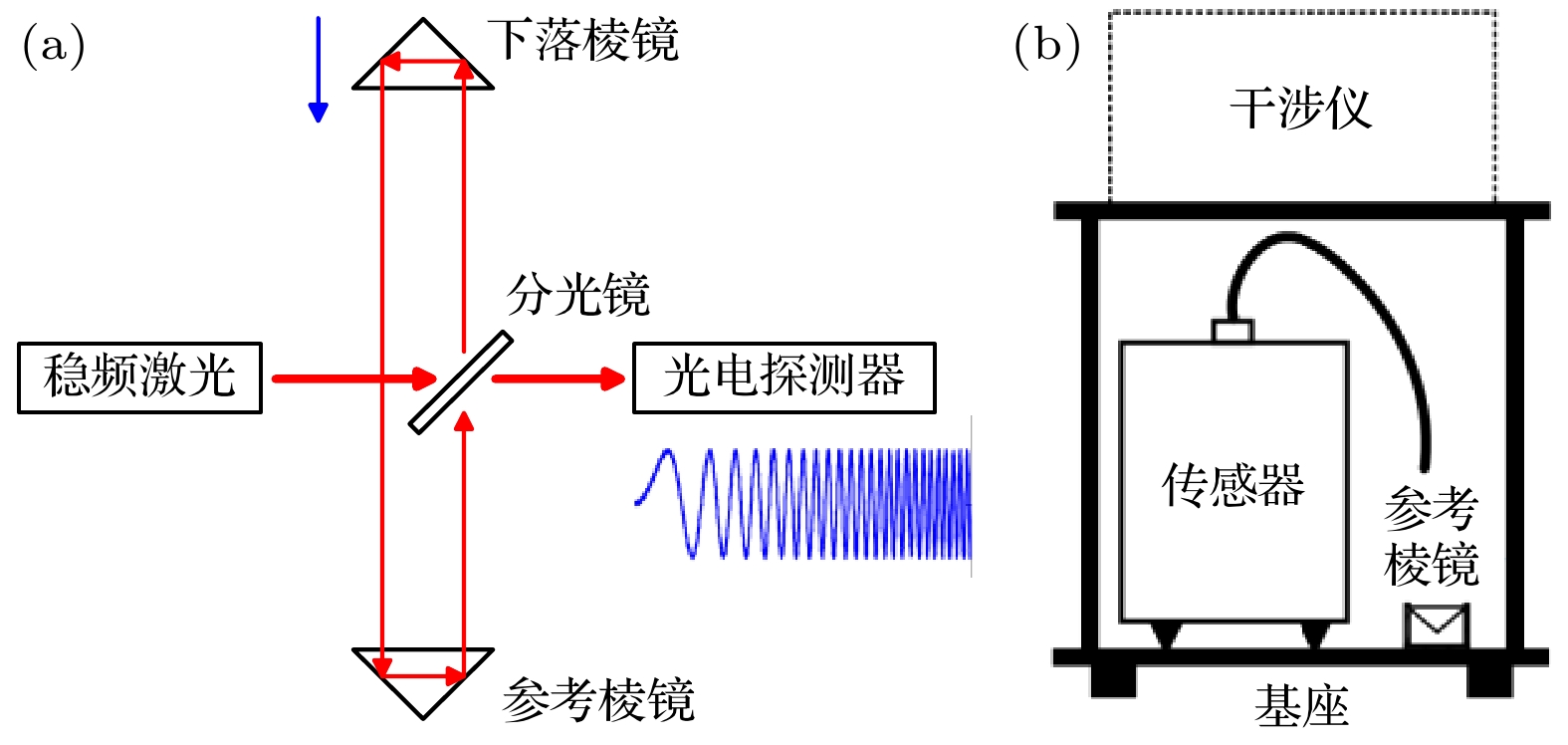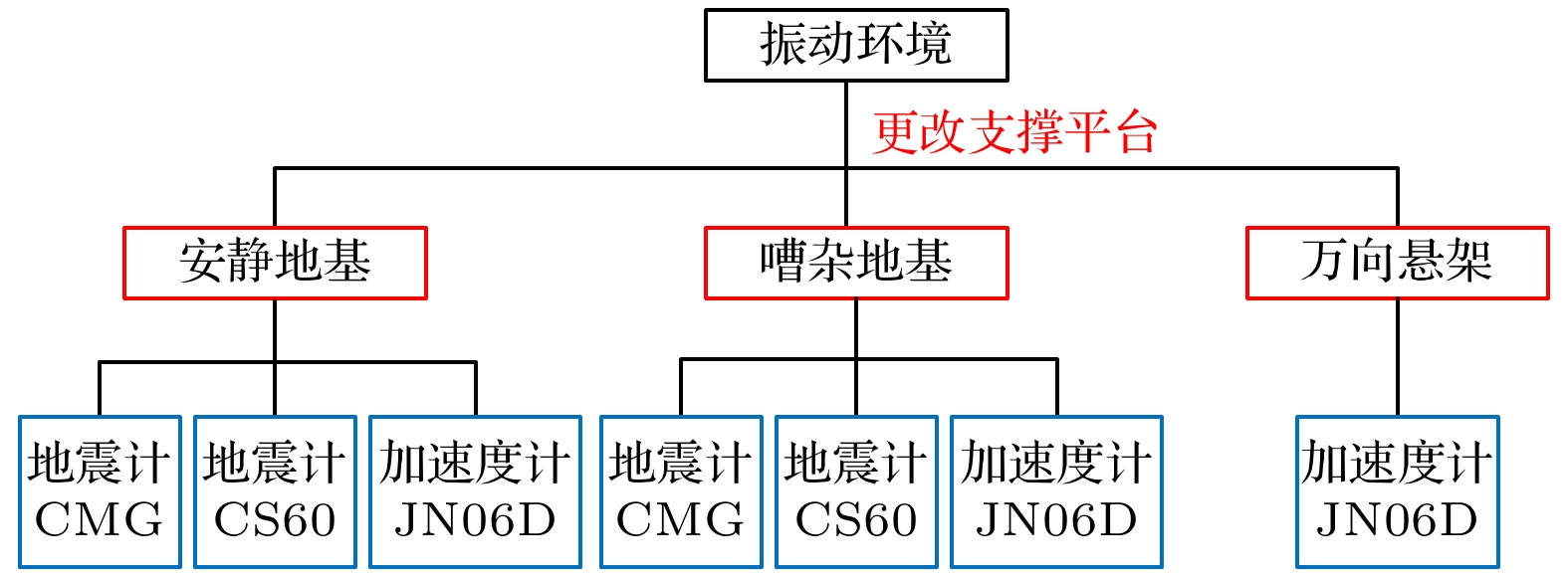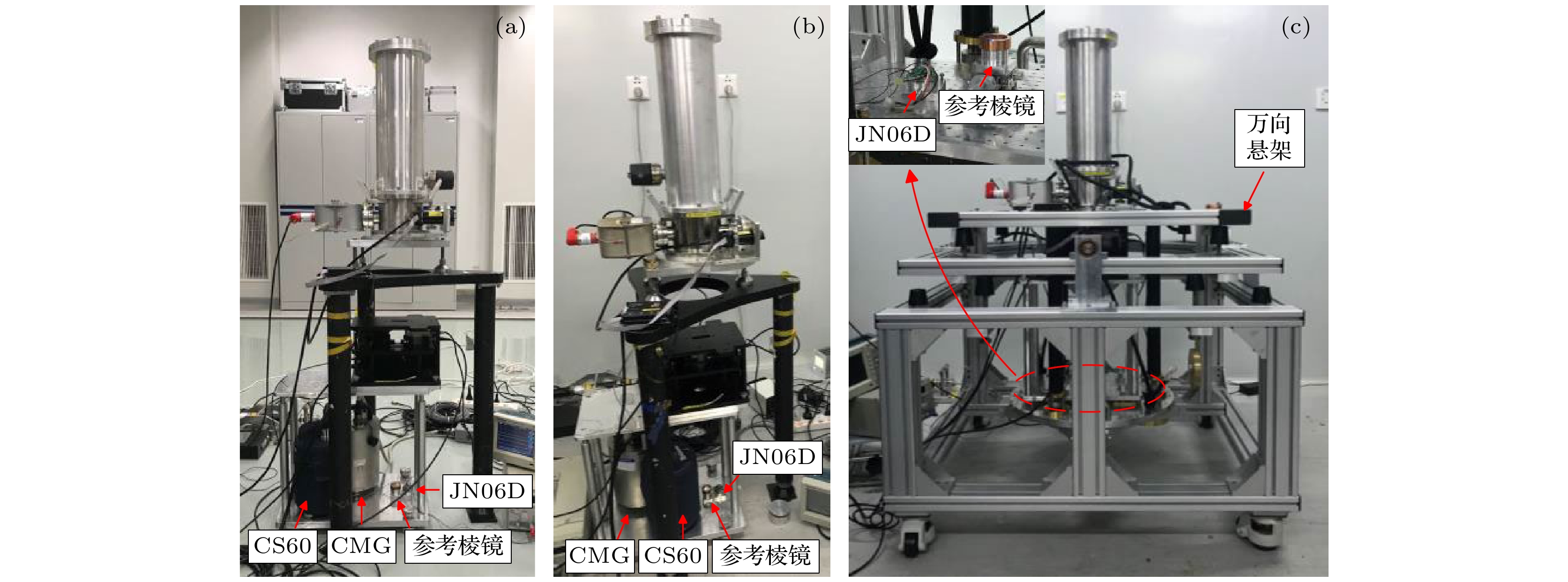-
Absolute gravity measurement refers to the measurement of the absolute value of gravitational acceleration (g, approximately 9.8 m/s2). The precision of absolute gravity measurement is limited mainly by vibration noises. Vibration correction is a simple and feasible way to deal with vibration noises, which corrects the measurement results by detecting vibration noises with a sensor. At present, the vibration correction performance of different sensors lacks systematic analysis and evaluation. In this paper, the theoretical analysis of how the sensor characteristics affect the correction performance is carried out. The vibration correction performances of three sensors, two different seismometers and one accelerometer, are evaluated experimentally in the three cases with different vibration noises. The experimental results show that the correction precision obtained by using low-noise seismometer is limited mainly by its bandwidth and range. In case I i.e. the quiet environment, the standard deviation of corrected results obtained by using both seismometers can reach tens of μGal (1 μGal = 10–8 m/s2), which is close to that obtained by using an ultra-low-frequency vibration isolator. However, in case II i.e. the noisy environment, the standard deviation of corrected results obtained by both seismometers increase to hundreds of μGal due to the enhancement of high-frequency vibration components. This means that the correction performances of both seismometers deteriorate, and the performance of seismometer with narrower bandwidth turns even worse. Moreover, two seismometers cannot even work in case III with stronger vibration noises due to the range limitation. On the other hand, the correction precision obtained by using accelerometer is affected mainly by its resolution which is on the order of mGal (1mGal = 10–5 m/s2). Its bandwidth can reach hundreds of or even thousands of hertz and its range is generally over ±2 g, which is large enough to meet the needs for noisy and dynamic applications. In case I, the standard deviation after correction with accelerometer is larger than that before correction. This is because the intensity of vibration noises in this case is close to or even smaller than the self-noise of accelerometer so that it could not be detected effectively by accelerometer. In case II, the resolution of accelerometer is sufficient to detect the vibration noises effectively. The standard deviation of the results is reduced from 2822 μGal to 1374 μGal after correction with accelerometer, and equal to a precision of 0.1 mGal after 100 drops. In case III where the amplitude of vibration noise rises to 0.1 m/s2 and seismometer cannot work, the accelerometer could still achieve a precision of 0.3 mGal after 100 drops. The systematic deviation is corrected from –1158 mGal to –285 μGal and the standard deviation is reduced from 34 mGal to 3.3 mGal. Therefore, the low-noise seismometer is more suitable for vibration correction in a quiet environment with stable foundation, which could realize a standard deviation superior to hundreds of μGal, while the accelerometer is more appropriate for vibration correction in a complex or dynamic environment, which could achieve a standard deviation of mGal-level. Finally, the present results and analysis provide a theoretical guidance for selecting and designing the sensors in vibration correction applications.
-
Keywords:
- absolute gravity measurement /
- vibration correction /
- vibration sensor
[1] Marson I, Faller J 1986 J. Phys. E:Sci. Instrum. 19 22
 Google Scholar
Google Scholar
[2] Faller J 2003 Metrologia 39 425
 Google Scholar
Google Scholar
[3] Faller J 2005 J. Res. Nat. Inst. Stand. Technol. 110 559
 Google Scholar
Google Scholar
[4] Marson I 2012 Int. J. Geophys. 2012 687813
 Google Scholar
Google Scholar
[5] Niebauer T M, Sasagawa G S, Faller J E, Hilt R, Klopping F 1995 Metrologia 32 159
 Google Scholar
Google Scholar
[6] 胡华, 伍康, 申磊, 李刚, 王力军 2012 物理学报 61 099101
 Google Scholar
Google Scholar
Hu H, Wu K, Shen L, Li G, Wang L J 2012 Acta Phys. Sin. 61 099101
 Google Scholar
Google Scholar
[7] Saulson P R 1984 Rev. Sci. Instrum. 55 1315
 Google Scholar
Google Scholar
[8] Haubrich R A, McCamy K 1969 Rev. Geophys. 7 539
 Google Scholar
Google Scholar
[9] Sorrells G G, Douze E J 1974 J. Geophys. Res. 79 4908
 Google Scholar
Google Scholar
[10] Cessaro R K 1994 Bull. Seismol. Soc. Am. 84 142
 Google Scholar
Google Scholar
[11] Timmen L, Rder R H, Schnüll M 1993 Bulletin Géodésique 67 71
 Google Scholar
Google Scholar
[12] Svitlov S 2012 Metrologia 49 706
 Google Scholar
Google Scholar
[13] Wen Y, Wu K, Guo M Y, Wang L J 2021 IEEE Trans. Instrum. Meas. 70 1003607
 Google Scholar
Google Scholar
[14] Rinker R, Faller J 1981 Proceedings of Precision Measurement and Fundamental Constants Gaithersburg, Maryland, USA, June 8–12, 1981 p411
[15] Brown J M, Niebauer T M, Klingele E 2001 Int. Assoc. Geod. Symp. 123 223
 Google Scholar
Google Scholar
[16] Wang G, Hu H, Wu K, Wang L J 2017 Meas. Sci. Technol. 28 035001
 Google Scholar
Google Scholar
[17] Qian J, Wang G, Wu K, Wang L J 2018 Meas. Sci. Technol. 29 025005
 Google Scholar
Google Scholar
[18] 许翱鹏 2016 博士学位论文 (浙江: 浙江大学)
Xu A P 2016 Ph. D. Dissertation (Zhejiang: Zhejiang University) (in Chinese)
[19] Le Gouët J, Mehlstäubler T, Kim J, Merlet S, Clairon A, Landragin A, Pereira dos Santos F 2008 Appl. Phys. B 92 133
 Google Scholar
Google Scholar
[20] Merlet S, Le Gouët J, Bodart Q, Clairon A, Landragin A, Pereira dos Santos F, Rouchon P 2009 Metrologia 46 87
 Google Scholar
Google Scholar
[21] Baumann H 2012 Geophys. Prospect. 6 361
 Google Scholar
Google Scholar
[22] Bidel Y, Zahzam N, Blanchard C, Bonnin A, Cadoret M, Bresson A, Rouxel D, Lequentrec-Lalancette M F 2018 Nat. Commun. 9 627
 Google Scholar
Google Scholar
[23] Bidel Y, Zahzam N, Bresson A, Blanchard C, Cadoret M, Olesen A V, Forsberg R 2020 J. Geod. 94 20
 Google Scholar
Google Scholar
[24] 程冰, 周寅, 陈佩军, 张凯军, 朱栋, 王凯楠, 翁堪兴, 王河林, 彭树萍, 王肖隆, 吴彬, 林强 2021 物理学报 70 040304
 Google Scholar
Google Scholar
Cheng B, Zhou Y, Chen P J, Zhang K J, Zhu D, Wang K N, Weng K X, Wang H L, Peng S P, Wang X L, Wu B, Lin Q 2021 Acta Phys. Sin. 70 040304
 Google Scholar
Google Scholar
[25] 龙剑锋, 黄大伦, 滕云田, 吴琼, 郭欣 2012 地震学报 34 865
 Google Scholar
Google Scholar
Long J F, Huang D L, Teng Y T, Wu Q, Guo X 2012 Acta Seismologica Sinica 34 865
 Google Scholar
Google Scholar
[26] Wu S Q, Feng J Y, Li C Y, Su D W, Wang Q Y, Hu R, Hu L S, Xu J Y, Ji W X, Ullrich C, Palinkas V, Kostelecký J, Bilker-Koivula M, Näränen J, Merlet S, Le Moigne N, Mizushima S, Francis O, Choi I M, Newel D 2020 Metrologia 57 07002
 Google Scholar
Google Scholar
[27] Guo M Y, Wu K, Yao J M, Wen Y, Wang L J 2021 IEEE Trans. Instrum. Meas. 70 1004310
 Google Scholar
Google Scholar
-
图 3 (a)基于振动补偿的T-3型绝对重力仪示意图; (b) 基于超低频垂直隔振的T-3型高精度绝对重力仪在西安中心地震台的重力测量结果.
Figure 3. (a) Schematic diagram of T-3 type absolute gravimeter using vibration correction; (b) tidal gravity measurement conducted by T-3 type high-precision absolute gravimeter using ultra-low frequency vertical vibration isolator at Xi’an Seismological Station.
表 1 振动传感器性能指标
Table 1. Characteristics of vibration sensors.
型号 自噪声 –3 dB带宽 量程 CMG-3ESP 低于NLNM (40 s ~ 16 Hz) 0.0083—50 Hz 5 mm/s CS60 低于NLNM (100 s ~ 15 Hz) 0.0167—80 Hz 10 mm/s (1 Hz) JN06D –115 ~ –120 $ \rm dB\cdot g/\sqrt{Hz} $ (0 ~ 100 Hz) DC ~1360 Hz ± 30 g 表 2 实验结果
Table 2. Results of vibration correction experiments.
未补偿 地震计CMG 地震计CS60 加速度计JN06D 隔振SuperSpring 安静
地基系统偏差Δg/μGal –8 –9 –1 –75 3 单次标准差STD/μGal 120 71 66 578 68 嘈杂
地基系统偏差Δg/μGal 841 28 5 18 8 单次标准差STD/μGal 2822 511 289 1374 93 万向
悬架系统偏差Δg/μGal –1158415 –285 单次标准差STD/μGal 42793 3353 -
[1] Marson I, Faller J 1986 J. Phys. E:Sci. Instrum. 19 22
 Google Scholar
Google Scholar
[2] Faller J 2003 Metrologia 39 425
 Google Scholar
Google Scholar
[3] Faller J 2005 J. Res. Nat. Inst. Stand. Technol. 110 559
 Google Scholar
Google Scholar
[4] Marson I 2012 Int. J. Geophys. 2012 687813
 Google Scholar
Google Scholar
[5] Niebauer T M, Sasagawa G S, Faller J E, Hilt R, Klopping F 1995 Metrologia 32 159
 Google Scholar
Google Scholar
[6] 胡华, 伍康, 申磊, 李刚, 王力军 2012 物理学报 61 099101
 Google Scholar
Google Scholar
Hu H, Wu K, Shen L, Li G, Wang L J 2012 Acta Phys. Sin. 61 099101
 Google Scholar
Google Scholar
[7] Saulson P R 1984 Rev. Sci. Instrum. 55 1315
 Google Scholar
Google Scholar
[8] Haubrich R A, McCamy K 1969 Rev. Geophys. 7 539
 Google Scholar
Google Scholar
[9] Sorrells G G, Douze E J 1974 J. Geophys. Res. 79 4908
 Google Scholar
Google Scholar
[10] Cessaro R K 1994 Bull. Seismol. Soc. Am. 84 142
 Google Scholar
Google Scholar
[11] Timmen L, Rder R H, Schnüll M 1993 Bulletin Géodésique 67 71
 Google Scholar
Google Scholar
[12] Svitlov S 2012 Metrologia 49 706
 Google Scholar
Google Scholar
[13] Wen Y, Wu K, Guo M Y, Wang L J 2021 IEEE Trans. Instrum. Meas. 70 1003607
 Google Scholar
Google Scholar
[14] Rinker R, Faller J 1981 Proceedings of Precision Measurement and Fundamental Constants Gaithersburg, Maryland, USA, June 8–12, 1981 p411
[15] Brown J M, Niebauer T M, Klingele E 2001 Int. Assoc. Geod. Symp. 123 223
 Google Scholar
Google Scholar
[16] Wang G, Hu H, Wu K, Wang L J 2017 Meas. Sci. Technol. 28 035001
 Google Scholar
Google Scholar
[17] Qian J, Wang G, Wu K, Wang L J 2018 Meas. Sci. Technol. 29 025005
 Google Scholar
Google Scholar
[18] 许翱鹏 2016 博士学位论文 (浙江: 浙江大学)
Xu A P 2016 Ph. D. Dissertation (Zhejiang: Zhejiang University) (in Chinese)
[19] Le Gouët J, Mehlstäubler T, Kim J, Merlet S, Clairon A, Landragin A, Pereira dos Santos F 2008 Appl. Phys. B 92 133
 Google Scholar
Google Scholar
[20] Merlet S, Le Gouët J, Bodart Q, Clairon A, Landragin A, Pereira dos Santos F, Rouchon P 2009 Metrologia 46 87
 Google Scholar
Google Scholar
[21] Baumann H 2012 Geophys. Prospect. 6 361
 Google Scholar
Google Scholar
[22] Bidel Y, Zahzam N, Blanchard C, Bonnin A, Cadoret M, Bresson A, Rouxel D, Lequentrec-Lalancette M F 2018 Nat. Commun. 9 627
 Google Scholar
Google Scholar
[23] Bidel Y, Zahzam N, Bresson A, Blanchard C, Cadoret M, Olesen A V, Forsberg R 2020 J. Geod. 94 20
 Google Scholar
Google Scholar
[24] 程冰, 周寅, 陈佩军, 张凯军, 朱栋, 王凯楠, 翁堪兴, 王河林, 彭树萍, 王肖隆, 吴彬, 林强 2021 物理学报 70 040304
 Google Scholar
Google Scholar
Cheng B, Zhou Y, Chen P J, Zhang K J, Zhu D, Wang K N, Weng K X, Wang H L, Peng S P, Wang X L, Wu B, Lin Q 2021 Acta Phys. Sin. 70 040304
 Google Scholar
Google Scholar
[25] 龙剑锋, 黄大伦, 滕云田, 吴琼, 郭欣 2012 地震学报 34 865
 Google Scholar
Google Scholar
Long J F, Huang D L, Teng Y T, Wu Q, Guo X 2012 Acta Seismologica Sinica 34 865
 Google Scholar
Google Scholar
[26] Wu S Q, Feng J Y, Li C Y, Su D W, Wang Q Y, Hu R, Hu L S, Xu J Y, Ji W X, Ullrich C, Palinkas V, Kostelecký J, Bilker-Koivula M, Näränen J, Merlet S, Le Moigne N, Mizushima S, Francis O, Choi I M, Newel D 2020 Metrologia 57 07002
 Google Scholar
Google Scholar
[27] Guo M Y, Wu K, Yao J M, Wen Y, Wang L J 2021 IEEE Trans. Instrum. Meas. 70 1004310
 Google Scholar
Google Scholar
Catalog
Metrics
- Abstract views: 8388
- PDF Downloads: 175
- Cited By: 0















 DownLoad:
DownLoad:















